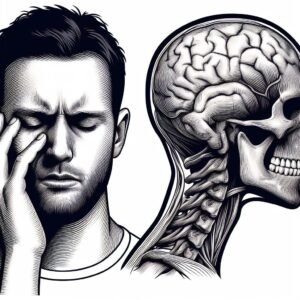Do you often experience jaw pain or difficulty chewing? You may be dealing with TMJ, a common condition affecting the temporomandibular joint.
In this article, we will explore what TMJ is, the symptoms to watch out for, and the various treatment options available.
Discover how to manage your TMJ symptoms effectively and regain control over your daily life.
Key Takeaways
- TMJ refers to the temporomandibular joint disorder, which is characterized by symptoms like jaw pain, headaches, difficulty chewing, and clicking sounds when opening and closing the mouth.
- The causes and triggers of TMJ can include misalignment of the jaw joint, teeth grinding or clenching, trauma or injury to the jaw, and identifying triggers to prevent TMJ.
- The diagnosis of TMJ involves assessing symptoms and medical history, conducting a physical examination of the jaw joint, and may require additional tests like X-rays, CT scans, or MRI scans.
- Treatment options for TMJ can include medications, physical therapy, dental treatments, and managing symptoms through lifestyle modifications such as avoiding aggravating activities, practicing relaxation techniques, applying heat or cold packs, and modifying the diet.
Common Symptoms of TMJ
If you experience jaw pain, headaches, or difficulty chewing, you may be experiencing common symptoms of TMJ. TMJ, or temporomandibular joint disorder, affects the joints and muscles that control the movement of your jaw.
Jaw pain is often one of the first signs of TMJ, and it can range from a dull ache to severe discomfort. Headaches are another common symptom, typically occurring in the temples or at the back of the head. These headaches can be persistent and may worsen with jaw movement.
Difficulty chewing or a clicking sound when you open and close your mouth are also indicators of TMJ.
If you’re experiencing any of these symptoms, it’s important to consult a healthcare professional for an accurate diagnosis and appropriate treatment.
Causes of TMJ
To understand the causes of TMJ, let’s delve into the factors that contribute to the development of this condition. TMJ, or temporomandibular joint disorder, can be caused by various factors, including:
- Misalignment of the jaw joint: When the jaw joint isn’t properly aligned, it can put excessive strain on the surrounding muscles and tissues, leading to TMJ.
- Excessive teeth grinding or clenching: Habitually grinding or clenching your teeth can exert pressure on the jaw joint, causing it to become inflamed and leading to TMJ.
- Trauma or injury to the jaw: A direct blow to the jaw or a whiplash injury can damage the jaw joint, resulting in TMJ.
Understanding these causes can help in identifying the triggers and preventing the development of TMJ.
Now, let’s move on to the next section, which explores how TMJ is diagnosed.
How TMJ Is Diagnosed
To diagnose TMJ, your dentist or doctor will assess your symptoms and conduct a thorough examination of your jaw joint and surrounding areas. They’ll begin by asking about your medical history and any symptoms you may be experiencing, such as pain, clicking or popping sounds, difficulty opening or closing your mouth, or jaw locking.
They’ll then perform a physical examination, checking for any abnormalities or tenderness in the jaw joint, muscles, and surrounding tissues. Your dentist or doctor may also order additional tests, such as X-rays, CT scans, or MRI scans, to get a more detailed view of the jaw joint and to rule out other possible causes of your symptoms.
These diagnostic tests can help confirm a TMJ diagnosis and guide the appropriate treatment plan for you.
Available Treatment Options for TMJ
Once your TMJ diagnosis is confirmed, your dentist or doctor will discuss with you the available treatment options for managing your symptoms. Here are some of the treatment options that may be recommended:
- Medications: Your healthcare provider may suggest over-the-counter pain relievers, muscle relaxants, or anti-inflammatory drugs to help alleviate your TMJ symptoms.
- Physical therapy: A physical therapist can teach you exercises and stretches to strengthen your jaw muscles and improve your jaw’s range of motion.
- Dental treatments: Your dentist may recommend dental splints or mouthguards to help realign your bite and alleviate pressure on your jaw joint.
By exploring these treatment options, you can find relief from TMJ symptoms and improve your quality of life.
However, in addition to these treatments, there are also some tips for managing TMJ symptoms that you can incorporate into your daily routine.
Tips for Managing TMJ Symptoms
To effectively manage your TMJ symptoms, it’s important to incorporate certain tips into your daily routine.
First and foremost, try to avoid activities that aggravate your jaw, such as chewing gum or biting your nails.
Additionally, practicing relaxation techniques like deep breathing and meditation can help reduce stress, which is known to worsen TMJ symptoms.
Applying heat or cold packs to the affected area can also provide temporary relief.
It may be helpful to modify your diet by avoiding hard, chewy foods and opting for softer options instead.
Furthermore, maintaining good posture and avoiding excessive jaw movements can alleviate symptoms.
Conclusion
So, if you’ve been experiencing jaw pain, headaches, or difficulty chewing, you may be dealing with TMJ.
It’s important to seek a diagnosis from a healthcare professional to determine the underlying cause and find the right treatment.
Whether it’s through medication, physical therapy, or lifestyle changes, there are options available to manage TMJ symptoms and improve your quality of life.
Don’t let TMJ hold you back from enjoying a pain-free life.

Mr. Mark Rogers is independent health investigator with over 25+ years of experience. He’s also a father and past TMJ sufferer. He’s explored numerous treatment options and found the most lasting relief from Neuromuscular Release Therapy. His passions include biohacking, cycling, and spending time with his family. He’s based out of beautiful Atlanta, Georgia. You can find him on his social profiles below.